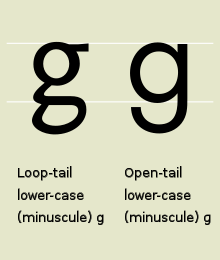
Back بدل خطي Arabic Алаграф Byelorussian Alograf BS Allograph German Alografo Esperanto Allographe French Alografo IO Allografo Italian Аллографа Kazakh Alografia Portuguese

In graphemics and typography, the term allograph is used of a glyph that is a design variant of a letter or other grapheme, such as a letter, a number, an ideograph, a punctuation mark or other typographic symbol. In graphemics, an obvious example in English (and many other writing systems) is the distinction between uppercase and lowercase letters. Allographs can vary greatly, without affecting the underlying identity of the grapheme. Even if the word "cat" is rendered as "cAt", it remains recognizable as the sequence of the three graphemes ⟨c⟩, ⟨a⟩, ⟨t⟩.[1]
Letters and other graphemes can also have significant variations that may be missed by many readers. The letter g, for example, has two common forms in different typefaces, and a wide variety in people's handwriting. A positional example of allography is the long s |ſ|, a symbol which was once a widely used as a non-final allograph for the lowercase letter s.
A grapheme variant can acquire a separate meaning in a specialized writing system, such as the International Phonetic Alphabet used in linguistics. Several such variants have distinct code points in Unicode and thus are not allographs for some applications.[2]